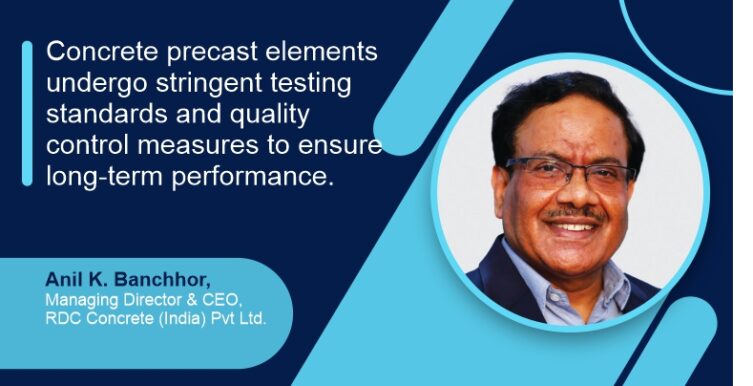Concrete precast elements undergo stringent testing standards and quality control measures to ensure long-term performance
In an interview with B2B Purchase, Anil K. Banchhor of RDC Concrete (India) Pvt Ltd, a leading name in the construction industry, shares its innovative concrete precast solutions and their real-world applications.
How has the adoption of concrete precast technology transformed the construction industry’s efficiency and project timelines?
The adoption of concrete precast technology has significantly transformed the construction industry by enhancing efficiency and expediting project timelines. Manufacturing precast elements off-site in controlled conditions enables simultaneous progress at the construction site, reducing overall construction time. The rigorous quality control during manufacturing ensures consistency and durability. Furthermore, precast construction’s reduced site disruption, weather independence, and sustainability benefits contribute to a more streamlined and environmentally conscious construction process, ultimately leading to shorter project lifecycles and improved overall project outcomes.
What are the key factors influencing the design versatility and structural integrity of concrete precast components?
The design versatility and structural integrity of concrete precast components are influenced by a confluence of key factors. Material selection plays a pivotal role, encompassing the choice of concrete mixtures, aggregates, and reinforcing materials, which collectively dictate the component’s strength, durability, and appearance. Manufacturing processes and technologies adopted during precasting significantly impact design possibilities, as advanced techniques allow for intricate shapes, surface finishes, and textures. Precast component geometry and connection mechanisms also affect design flexibility and structural soundness, with considerations for load distribution, stress concentrations, and ease of assembly.
Adherence to rigorous quality control protocols at every stage, from material batching to curing, is imperative to ensure consistent performance and longevity. Environmental conditions and exposure scenarios must be factored into the design to counteract potential degradation mechanisms. Lastly, collaboration between architects, engineers, and manufacturers from the early design stages fosters innovative solutions that balance aesthetics, functionality, and structural performance, ultimately enhancing the adaptability and strength of concrete precast components.
How does the cost-effectiveness of concrete precast compare to traditional on-site concrete pouring in large-scale construction projects?
The cost-effectiveness of using precast concrete compared to traditional on-site concrete pouring in large-scale construction projects can vary depending on several factors. It’s not accurate to make a blanket statement that precast concrete is always more costly than traditional on-site pouring, as both methods have their advantages and disadvantages, and their cost-effectiveness can be influenced by specific project requirements and circumstances.
Whether precast concrete or traditional on-site pouring is more cost-effective for a large-scale construction project depends on the specific project parameters, design requirements, and local conditions. While precast concrete may have higher upfront costs in some cases, it can offer advantages in terms of speed, quality control, and long-term maintenance that make it a cost-effective choice for certain projects. An accurate cost analysis should be conducted for each project to determine the most cost-effective approach.
What are the rigorous testing standards and quality control measures ensuring the long-term performance of concrete precast elements?
Concrete precast elements undergo stringent testing standards and quality control measures to ensure long-term performance. These include rigorous material testing, mix design optimisation, and adherence to established industry codes and standards. Quality checks are performed at various stages, from batching to curing, encompassing visual inspections, dimensional accuracy assessments, and mechanical property testing. Factory production controls, standard operating procedures, and skilled personnel contribute to consistent quality. Continuous monitoring and documentation at every step of the production process further ensure the reliability and longevity of concrete precast elements.
Which projects have you commenced and completed with the new-age concrete/precast methods?
At RDC, our extensive product portfolio encompasses a range of New Age Concrete solutions tailored to meet the diverse needs of our clients. Among our notable offerings are Tempcrete, designed to lower the core temperature of raft foundations, Supercrete, capable of achieving impressive compressive strengths up to M100, and Fastrackcrete, which attains high strength within a matter of hours. Our products have found applications in a wide array of construction projects, including underground metros, high-rise buildings, bridges, industrial facilities, and modular construction for housing and hotels.
Cookie Consent
We use cookies to personalize your experience. By continuing to visit this website you agree to our Terms & Conditions, Privacy Policy and Cookie Policy.
















